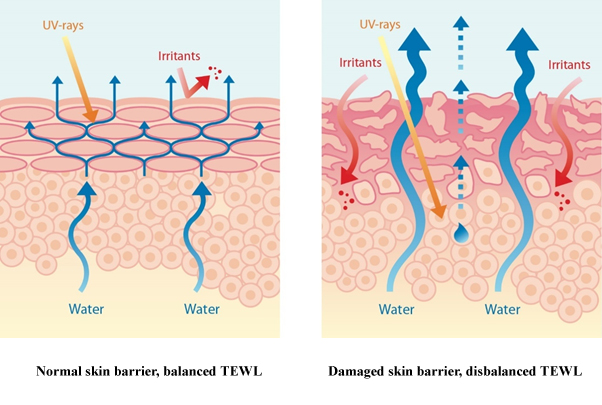Understanding Transepidermal Water Loss (TEWL) is like unlocking a secret door to better skin care practices and, ultimately, healthier skin. So, let's discuss how the skin fights every day against environmental factors and pollution to protect this bad boy...
What is TEWL?
Transepidermal Water Loss, or TEWL, might sound like a complex term, but it's a simple yet powerful way to gauge your skin's health. Imagine your skin barrier as a bouncer. The bouncer's job is not only to protect you from things that shouldn't be inside like bad bacteria but also to keep precious resources, like water, from escaping. When too much water is lost, your skin can become dry, irritated, and more susceptible to conditions such as eczema or psoriasis. That's TEWL in a nutshell - the measurement of how much water your skin loses to the environment.

But TEWL isn't just about dry skin. It's a sign of how well your skin is performing its barrier function. A healthy skin barrier retains the right amount of moisture while keeping out harmful substances. When this barrier is compromised, problems aren't far behind. Increased TEWL can lead to a breakdown of this barrier, making it easier for irritants, allergens, and pollutants to penetrate the skin and cause inflammation and damage.
Physiological differences amongst ethnicities | TEWL
Interestingly, research has identified racial differences in skin's physiological traits, affecting moisture content and its response to external agents. These differences suggest that certain moisturizing products may be more effective for some ethnic groups than others. While a myriad of moisturizers exist to combat dry skin, their varying mechanisms can have differing degrees of effectiveness across racial lines, influenced by factors such as skin's water loss, water content, and lipid levels.
The management of dry or dehydrated skin goes beyond simple hydration; it involves understanding the complex interplay between individual genetic factors and environmental exposures. As the skin care industry evolves, tailoring treatments to align with these nuances becomes increasingly essential to effectively maintain skin moisture and barrier function.
The Impact of Environment and Pollution on TEWL
Environmental conditions and pollution, play a role in TEWL and, by extension, our skin health.
Pollution: The Invisible Enemy
It turns out, according to studies, pollution is a significant culprit in increasing TEWL. Particles from car exhaust, industrial emissions, and even some gases can poke microscopic holes in our skin's protective barrier, allowing moisture to escape more freely. This not only dehydrates the skin but can also lead to increased sensitivity and aggravation of skin conditions like dermatitis.
But it's not just about the moisture loss. The infiltration of these pollutants can spark a chain reaction, leading to inflammation, redness, and a weakened skin structure. As these tiny invaders settle into your skin, they can cause oxidative stress, which is just as menacing and annoying as it sounds. It's a process that can accelerate cellular aging/death, disrupt skin repair, and leave you looking and feeling less than your best.
The Weather Factor
The effect of seasons and weather on TEWL is a mixed bag of results. Some studies indicate that summer's heat increases moisture loss, while others point to winter's harsh cold as the main offender. In my experience with thousands of facials, humidity plays a huge role...and in Southern California, winter is the biggest offender. Extreme conditions, whether hot or cold, can disrupt our skin's natural moisture balance, leading to increased TEWL. However, there's no consensus, indicating that how our skin reacts to seasonal changes can be highly individual.
The weather's impact goes beyond the temperature....factors like wind speed, humidity, and even your geographical location can influence TEWL. The skin's battle to maintain its hydration is a complex interplay of internal and external factors, and even the most resilient skin can be affected by a change in the weather.

Twins (natural age 61) with significant difference in sun exposure. Twin B (B) had approximately 10 hours per week greater sun exposure than twin A (A). Twin A had a body mass index 2.7 points higher than that of twin B. The perceived age difference was 11.25 years. Reprinted with permission from Plast Reconstr Surg. 2009;123(4):1321–1331.
Why Does This Matter?
Understanding the dynamics of TEWL is crucial for several reasons. First, it helps us pinpoint factors that may be harming our skin's health without us even realizing it. Equipped with this knowledge, we can seek out products and routines designed to strengthen our skin's barrier, lock in moisture, and protect against environmental aggressors.
We need to continue to explore ways in how our surroundings affect our skin. As we learn more, we can better equip ourselves to strengthen our skin's health, ensuring it remains hydrated, resilient, and radiant.
Moving Forward
TEWL is an ongoing balancing game, but every piece of research brings us closer to understanding how to protect and nurture our skin against the environmental challenges it faces daily. By staying informed and adjusting our skincare routines accordingly (I like to recommend quarterly if not biannually), we can help our skin.
Remember, your skin is your body's first line of defense against the outside world. Taking care of it means more than just looking good...it's about staying healthy. Keep an eye out for more insights and tips on how to keep your skin in top shape, no matter what the environment throws at it.
Stay hydrated, stay protected...talk soon!
Reference:
Farkas, J. P., Pessa, J. E., Hubbard, B., & Rohrich, R. J. (2013, April). The Science and Theory behind Facial Aging. Plastic and Reconstructive Surgery Global Open, 1(1), 1–8. https://doi.org/10.1097/gox.0b013e31828ed1da
Green, M., Kashetsky, N., Feschuk, A., & Maibach, H. I. (2022, February 25). Transepidermal water loss (TEWL): Environment and pollution—A systematic review. Skin Health and Disease, 2(2). https://doi.org/10.1002/ski2.104
